Preparing for the Incoming Computer Shopper Tsunami —
There’s no way for me to know where your awareness starts with all this, so let’s just start at the beginning.
Computer Shopper was a hell of a magazine. I wrote a whole essay about it, which can be summarized as “this magazine got to be very large, very extensive, and probably served as the unofficial ‘bible’ of the state of hardware and software to the general public throughout the 1980s and 1990s.” While it was just a pleasant little computer tabloid when it started in 1979, it quickly grew to a page count that most reasonable people would define as “intimidating”.
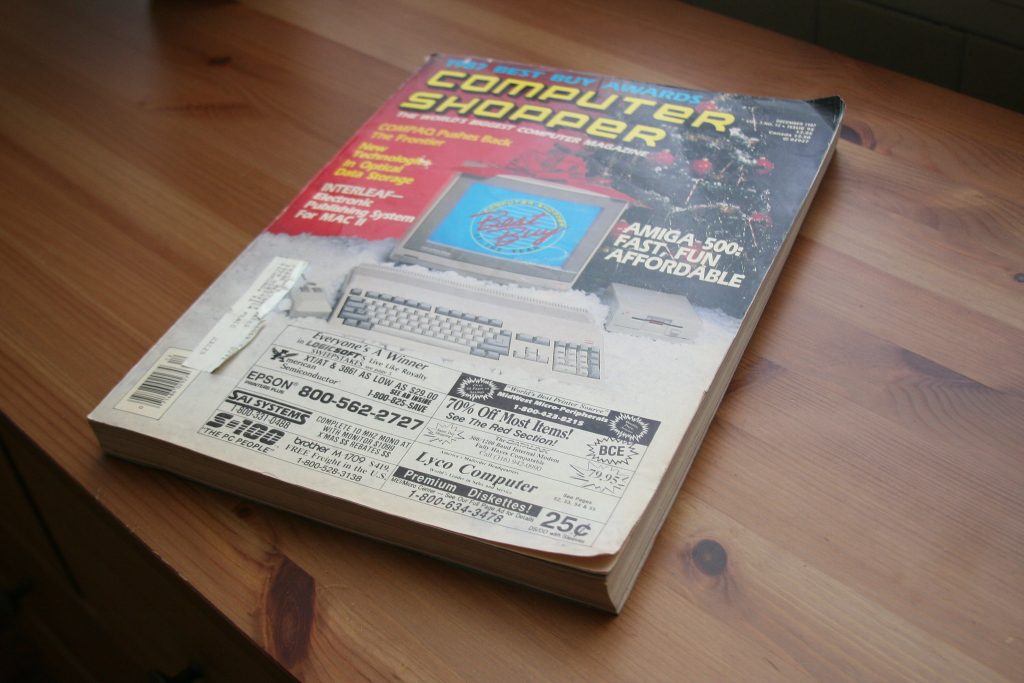
In a world that saw hundreds of magazines and thousands of newsletters come and go about technology and computer-related subjects, Computer Shopper was its own thing entirely. Not only thick as a brick, but clearly opened to anyone who waved cash and covering vendors who were selling computer components down to the individual part level. You might have a good set of ads in PC Magazine but to browse over price lists of capacitors, power supplies and wiring, the massive monthly Computer Shopper issue was going to be your go-to.
There were two other aspects to Computer Shopper that has given it a halo of intrigue and positive memory: First, the paper was incredibly cheap, newspaper tabloid level by some eyes. This seeming disposability infers a weird sort of honesty about the advertising contents – it is what it is, it represents what the actual pricing is, and what’s actually available. The lack of pure slickness in the printing process was a baggage of “look, I’m lucky if we survive another month and this is the straight up price we’re offering” across the many hundreds of ads in a given issue.

But second, was the full-bore willingness to seemingly absorb anything computer adjacent into its pages. Pre-fab computers and commercially available software was listed inside, sure. But if you were selling tech clothing, clips, floppies, tapes, plugs, paper, switches and accessories… you had a home there as well. It gave a truly manic and freewheeling melee to the affair, and for those of us who wanted to know more than the standard 20-30 software packages everyone was buying, or to think about smacking together a bunch of parts to get a mutant-powerful system up and running, this was the place.
To a smaller set of us, the BBS Listings in the back were also a very notable aspect. BBS operators across all the spectrum of cliques and locations thought of Computer Shopper as the BBS yellow pages, the phone book of the online, for almost its entire run. You flipped to the back, found your area code or state, and downright eye-watering levels of BBS listings were waiting for you. Inaccurate? Sometimes. But a truly unique assemblage of what was.

That catches us all up to what Computer Shopper was. Like many print-based computer magazines, Computer Shopper grew in size into the many of hundreds of pages, some greater than 800. It thrived in the world before the World Wide Web took hold, and once you could do daily updates of parts and prices at various websites, the months-lag in printing schedule and the lack of responsiveness compared to websites made it lose curry, favor, and eventually pages. It died a quiet death in 2009, becoming a barely interesting site and then an uninteresting zombie.
Still, it was a heck of a run.
People often ask me the same basic questions regarding old computer history and access to it. One of them is to discuss potential holy grails, possibilities of where some effort might be afforded to acquire potentially lost information or artifacts before they’re gone.
A common go-to for me was Computer Shopper, because it’s a perfect storm of absolute fascination and completely intolerable amounts of barriers towards digitizing it into something readable online.
- It’s fantastically huge. If you scan in an issue, however you do it, you’re talking hundreds of pages for that month, all of them requiring babysitting to ensure they got through.
- The cheap, cheap paper is a nightmare to run through a scanner – either a flatbed-based misery or a sheet-fed scanner that’s one molecule of damage away from crunching pages up.
- The gutters (space between the spine and the information on the page) is offensively small – millimeters where there should be a half-inch. Especially towards the 1990s era, the instructions to advertisers about layout clearly didn’t make many bones about informing folks about margins. This means the books have to be split apart, a despicable sin that strikes against the heart of the pure.
- These myriad, no-gutter, cheaply-printed pages are both tabloid size and never considered text too small to allow. This means that not only is the page size not going to fit in 95% of the consumer scanners out there, but they’re going to need to be scanned at the highest level you can, to not miss anything. The page size, digitized, is going to be offensively huge.
So, the prospect this would ever happen was basically zero. You needed someone who had the time, inclination, and support to do what was going to be one of the more painful scanning projects extant.
It turned out to be me.
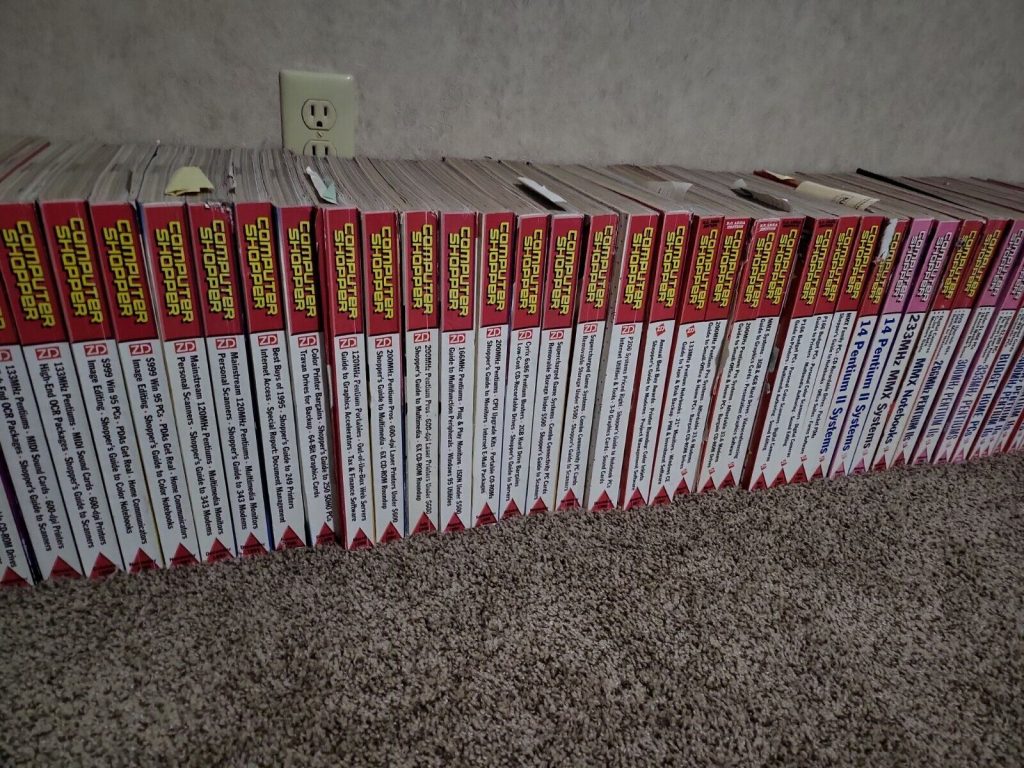
So, there I was whining online about how it was 2023 and nobody seemed to be scanning in Computer Shopper and we were going to be running into greater and greater difficulty to acquire and process them meaningfully, and I finally, stupidly said that if we happened on a somewhat-complete collection, I’d figure out how to do it.
And then an ebay auction came up that seemed to fit the bill.

Out in Ohio, someone decided to sell nearly 200 issues of Computer Shopper for a few thousand bucks.
It’s important to understand the usual per-issue prices for Computer Shopper, and that usual per-issue price can get as high as $50 an issue. Obviously, at some large scale, this becomes an untenably large price. But in this case, they were being sold for about $13 an issue, which is not zero, but somewhere in the realm of manageable: About $3,000 for the lot.
Now, I’m not going to have $3,000 to throw around like that. So I put the challenge out there: If people get together and give me $3,000, I’ll buy this lot and scan it it.
It hit goal in about 3 hours.

As you might have figured out, delivery/mail was not an option. To make that happen, I reached out for a volunteer, and a few people came forward, including Wes Kennedy, who made this his main project for a few days. He’d left one job and was starting another a week later, and “picking up all the issues, packaging them carefully, and putting them in the mail to Jason” became his fun-cation. He deserves all the kudos for this.
When 14 large boxes arrived, they included all the issues, put inside large paper envelopes and wrapped in blue plastic that definitely didn’t look like cocaine to the storage unit guys I cruised past.
So all of the issues were now safely within my control.
One might be inclined to say “Well, that’s only half the problem.” and you’d be off, because it’s actually less than a quarter of the problem. Acquisition, after all, was just money – buying issues in bulk and ending up with a good amount of them was just a case of assembling some cash.
No, it was definitely the scanning that was going to be the big …. issue.
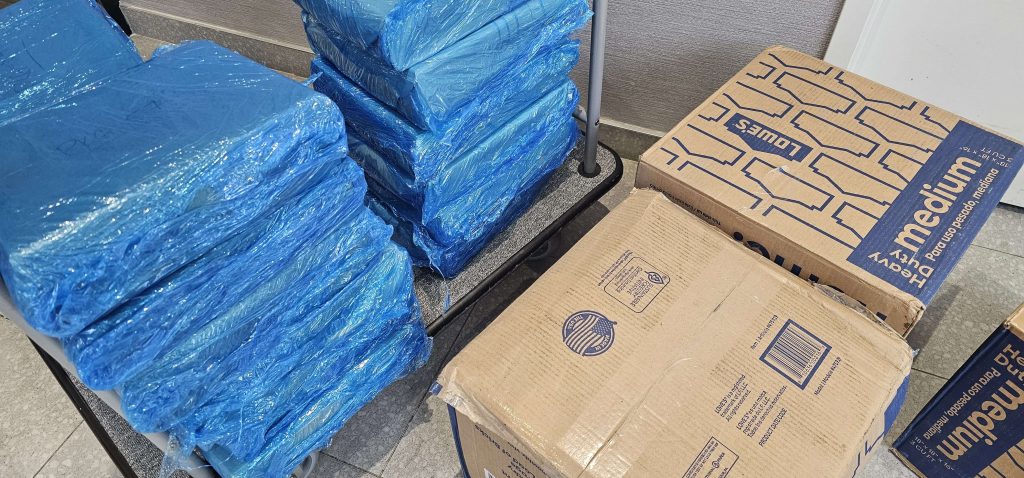
If not obvious, the pages of this tabloid-sized periodical are not just big, they’re over the bounds of pretty much every scanner out there, at least in the consumer space. (There’s plenty of large-format scanners past the $5,000 range, and they’re also gargantuan affairs, meant to handle blueprints and posters.)
But I did find one commercial scanner that could do the work: A Fujitsu fi-7480 wide-size sheet-feed scanner, which tops out at about $3,500. I’ll simply say a kind anonymous donor bought it outright so I wouldn’t have to crowdfund for it, and for that I’m eternally grateful.
Here’s what dealing with that process looks like, with the scanner software (Vuescan) set carefully to neutral and pulling in the massive pages through the fi-7480:
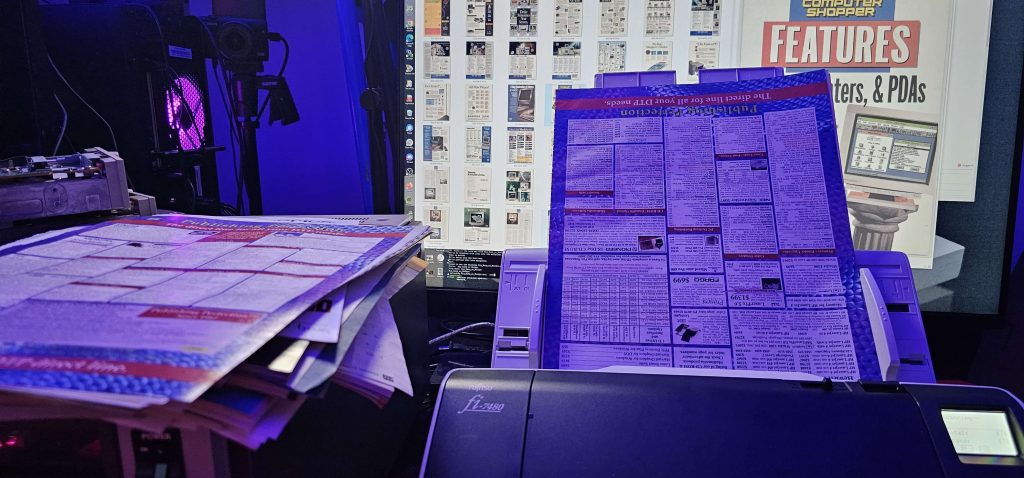
…which brings up the situation involving the pages.
Now, about 12 years ago, I really raked someone over the coals for destroying copies of BYTE magazine to scan them. He was not happy about this at all, and there’s a chance he may have stopped his project just not wanting to deal with such criticism. I hope not, but I do stand by the fact that he indicated he was immediately disposing of the pages after scanning them, which meant any mistakes or oversights were permanent. (At one point, he mentioned having to fish a page out of the trash when he discovered he’d skipped it.)
At that point, I made a declaration of my standards for debinding/pulling apart a magazine to scan it:
“IF I have a document or paper set that requires some level of destruction to scan properly AND IF I have three copies of it AND IF there is no currently-available digital version of the document AND IF there is a call or clamor for this document set THEN AND ONLY THEN I will split the binding and scan at a very high resolution and additionally apply OCR and other modern-day miracles to the resulting document so that the resulting item is, if not greater than the original, more useful to the world.”
…I should have added an OR.
“…OR if there’s very little chance of anyone ever being able to assemble issues to scan in the foreseeable future.”
Because that’s rapidly what was happening with the Computer Shoppers.
$13 an issue is perhaps quite a bit, but people want even more for individual issues and it will be a bit of a stretch to actually acquire them all. So, even though I don’t own 3 copies personally, I also know the other two potential copies are passing among collectors at this point, so they’re being held, in some way, in trust. It’s my hope that I’ll eventually have a chance to do this work for all the issues, but until then, I work with what I got.
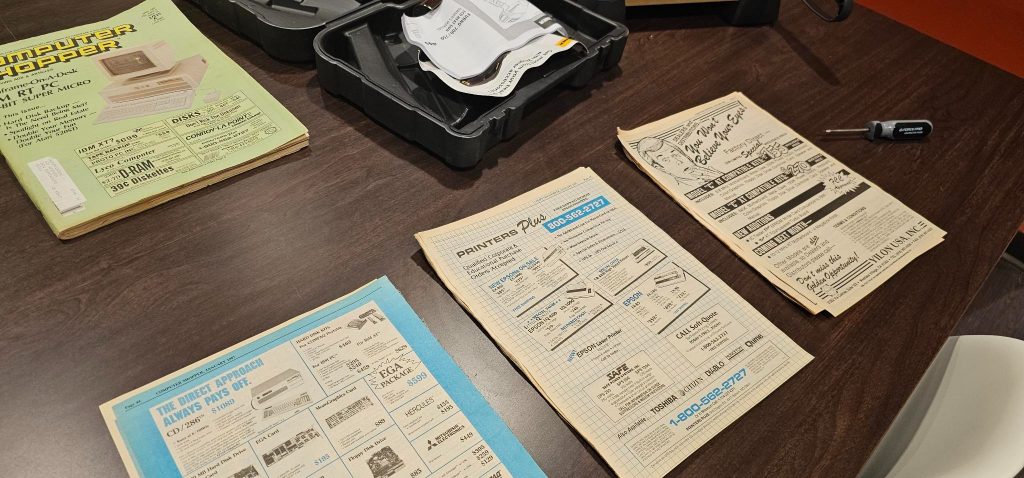

Debinding, the taking apart of a bound issue of a magazine to turn it into a stack of papers to scan in, turns out to be a process. A painful, time consuming, involved process. One which I knew would be involved but not as involved as it has definitely turned out to be.
Luckily, people have come before me. There is a rather beautiful documentation out there, about the best practices in debinding magazines, from Retromags. They walk through the pros and cons, the potential issues, the considerations while doing it, and the most common pitfalls that will befell your project if you don’t stay on top of them. I read this like the Book of Life before setting off on dealing with Computer Shoppers, because their “how to ski” primer was going to be critical as I skied backwards down a double-black-diamond slope of these bible-sized monsters.
In this case, I have to use a heat gun, aiming them at the glued issues of Computer Shopper, warming them up until the glue starts to become slightly liquid and then carefully pulling the pages apart from each other, placing them on a large table I’m working on. If the glue comes too close to the pages after I pull them apart, it actually sticks them back again. It’s a huge mess, and with hundreds of pages in a typical issue, hours of work.
There are banger groups out there working tirelessly to debind magazines, scan them in carefully, fix any issues with the looks, and upload them to various locations. One of them is Gaming Alexandria and it’s been a pleasure to fall in with them and discuss the nitty-gritty of this process. They’re scanning in obscure periodicals at scale and they know what they’re up to.
In fact, we’ve made a deal, where I’m just focusing on the “Raw Scans”, and these raws will go to them for post-processing, creating a more readable or functional set of final readable versions of Computer Shopper for people to appreciate. The Raws will always be available, of course – 600dpi TIFF files scanned neutrally of the original pages, placed together in mothra-sized .ZIP files that number up into the many gigabytes, for people to pull down when needed.
A scanned page of a typical issue looks like this (with a little size reduction for this essay):
You can see immediately the difficulties and intricacies of this project.
Like I indicated, there was very little care for margins, and none for minimum size of text. Computer Shopper advertisers did whatever they wanted, however they wanted, and into newsprint, which further made things whacky because bleed is a major issue, pulling the other side’s ink into the current one. And all of this on a massive piece of paper – so in total, the original TIFF file of this image is a full-on 20 megabytes – and this issue has over 400 pages.
And before I forget to mention… I did a test scan with an issue that I had two copies of, to work out any major bugs and problems. And one major problem was that there was a roller at the top of the feed scanner meant to separate a stack of pages into single ones and feed them in properly. Well, that roller grips the page so tightly, it started to pick up ink and put it on later pages, leaving streaks on the page. A quick browse through the service manual, and I had to remove that roller entirely. This means that I have to feed the pages in, one by one, since otherwise it’ll stick them together and jam.
Through all of this, we’re talking hours of work to do a single issue, and I have to do it a couple hundred times at least. This is going to be quite an epic task… which is, again, why we’re down to me doing it because the combination of cost, time and effort leaves almost nobody else who’d be in a position to be able to do, much less want to.

We did one issue, February 1986, “all the way through”. I debinded it, cropped it, scanned it, handed it to Gaming Alexandria to process, got it processed, and then put it on Internet Archive, resulting in three sets of images: The Raw Scans, a “Readable” version and an “Aesthetic” version.
The “Readable” version has been heavily processed and contrasted. It makes it very easy to read a page because it has a really nice dependable color setup for it:
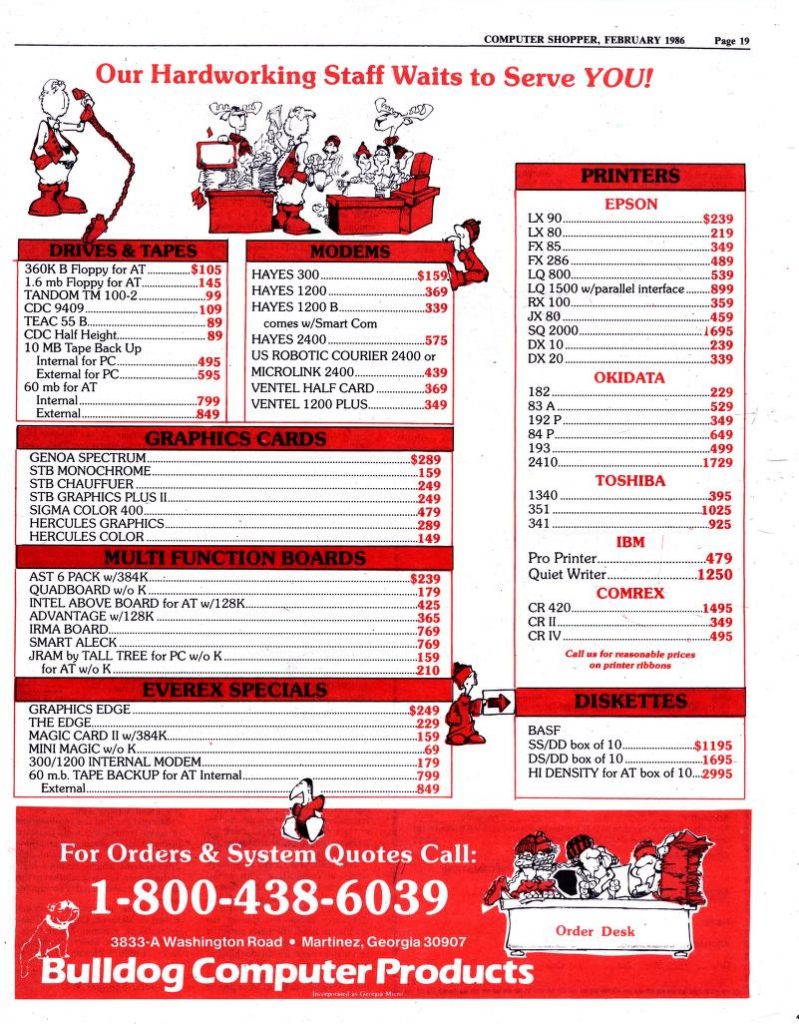
Contrasted with the “Aesthetic” version, that looks more like you would expect the newsprint and bleed-through original to look:
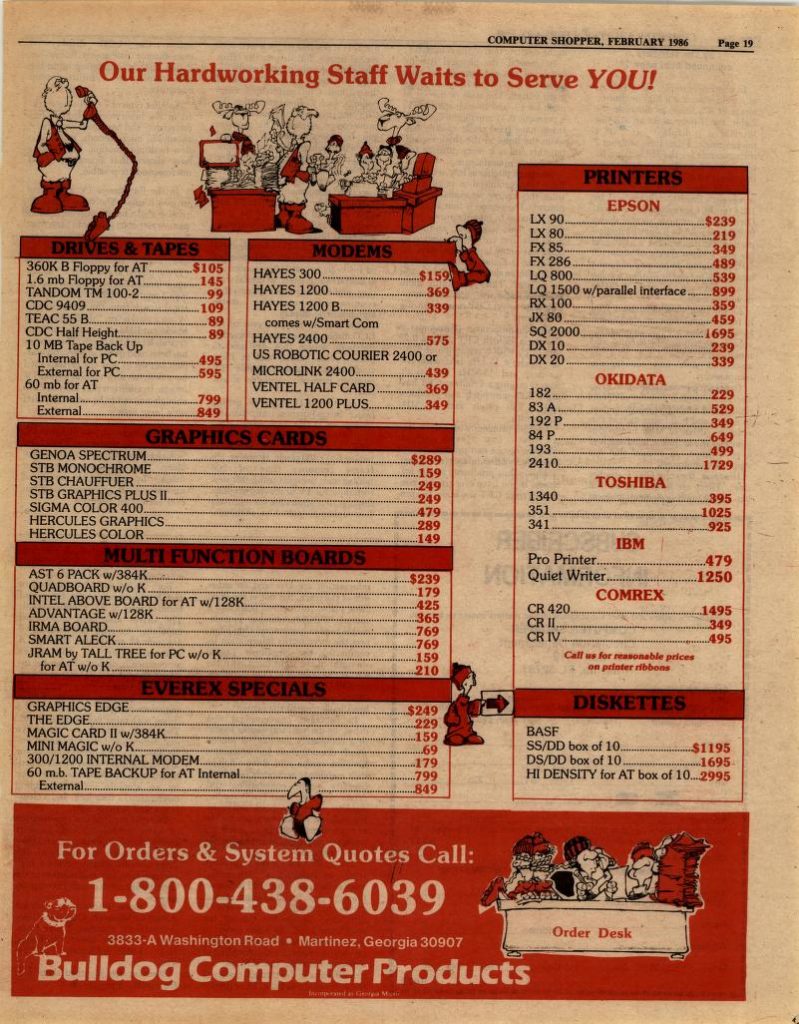
I personally prefer the “Aesthetic” – it brings me back to the way things were when I would buy Computer Shoppers at the local Microcenter and scour them for information and inspiration. But a researcher, and more importantly an Optical Character Recognizer prepping things for searches by researchers, will much prefer working with the Readable version.
Now, Here Comes The Pitch.
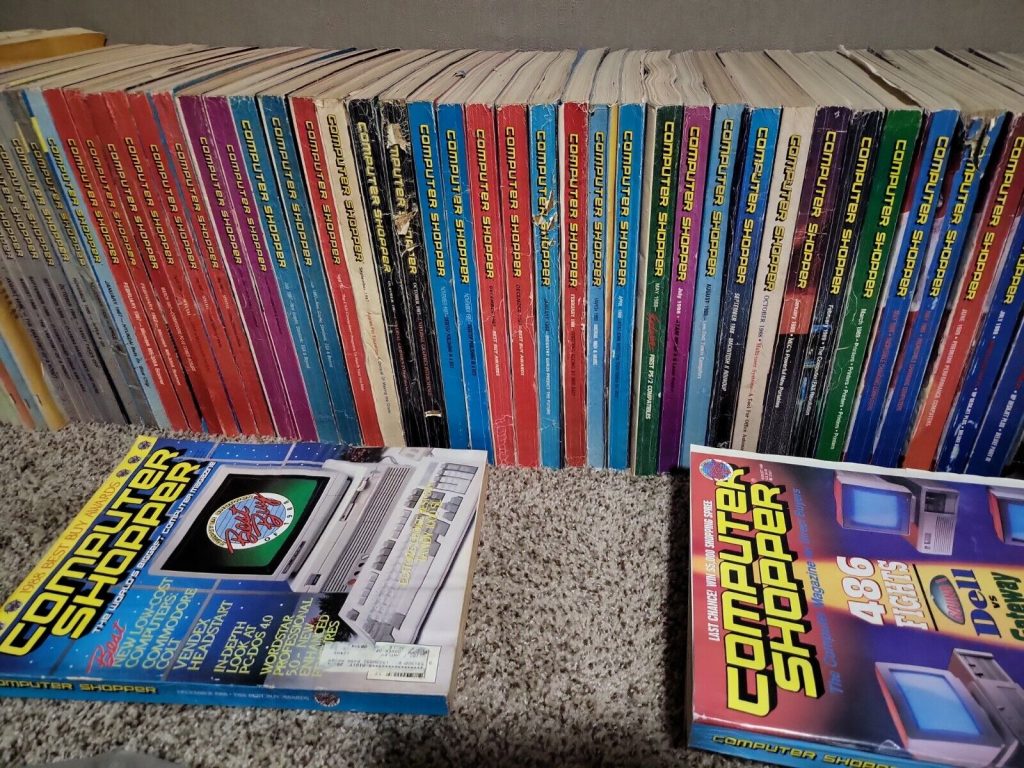
So, I live here now.
For the next however-long-it-takes, I’ll be debinding issues, doing careful scans of them, then putting the resulting piles of pages into baggies and sending them into cold storage for permanent holding, awaiting the next time they might have use, or to redo a problematic scan. That’s happening. I’m just going to be on this all year, when I can.
But this effort of mine is rather meaningless unless there are real humans and smart scripts going over what’s being produced.
By a back of the napkin calculation, there will be at least 100,000 and more likely 150,000+ pages of Computer Shopper issues scanned during this project. There’s going to be a lot of them, and they’re going to be jammed full of information, imagery, embarrassment and glory.
I really hope that a group of people, together or separately, start using this bounty to rip out BBS listings, find trends in pricing and nomenclature, in tracking down humble beginnings and finding other amazing tidbits throughout computing history.
It’s nice to drop 400-800 pages at once into an item, but unless I get some of those nerds out there scouring the pages for interesting things, it’s just me scanning into a void.
If you know people will be interested, help them become aware. And if you see something interesting, bring it out and make it part of sharing, wherever you want to.
This will be an incredible amount of work. Folks threw thousands of dollars into acquisitions of hardware and paper and I’m going to blast a lot of my personal time into scanning these.
Make it worth it.

Addendum:
This entry got a lot of attention. Two questions arose, and I’ll answer them both here:
Are There Missing Issues?
Yes, there are. Here’s the list. If people want to donate or buy good quality copies for me, mail me at jason@textfiles.com. Here’s the missing issues as far as I can tell:
- Everything before November 1983
- 1984: January, October, November
- 1985: October
- 1988: June, November
- 1989: April
- 1994: April, May, August, November
- 1995: February, March
- 1996: April, May, June
- 1997: July, September
- 1998: January, May
- 1999: April, July, August
If people send them to me, I’ll take them off this list. So if this list is here, I’m still missing them.
Can I Help Support You?
Just enjoy the Podcast. I spend a lot of time on it.
Categorised as: Uncategorized
Comments are disabled on this post
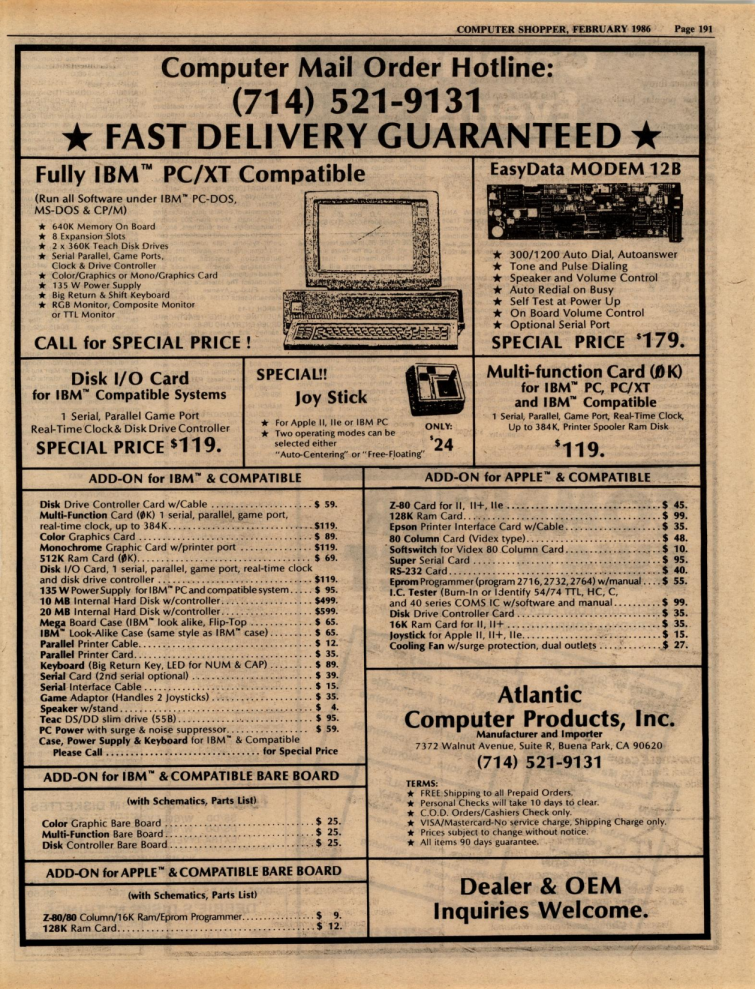
I second how awesome Hubz at Gaming Alexandria is. I worked with him a bit on his old scanning guide before dropping out to work on my SNES and PS2 manual scans. If they are helping with processing scans, I should see if they are up to fixing my PS1 raws- editing is slowing progress down.
I collected Computer Shoppers throughout the 80s and 90s- my uncle sold computers when I was a kid and I built easily 50+ systems as a sideline during my college years. Every month I would dig through the Computer Shopper looking for deals and tracking prices. I think I had about 12 feet of them stacked on my bookshelves before the ex cleaned house and chucked them all.
Godspeed, man!
I remember sitting in the back of a local used bookstore scouring the pages of Computer Shopper back issues when I was a kid. Great times!
This is awesome.
Incredible work there, as always Jason. Thank you and Gaming Alexandria (and other groups interested in preserving print history)
What else to say, Thank You!
Such magazines, frequently discarded initially, now are saving everyone who want to assemble computer from some specific time span. So that’s not only a “window” to the history.
And, if the de-binding is done specific way, it can be re-bound. The heat-melting glue is the best thing here as pages can be re-glued back. The polivinyl glue requiring chemistry to disassemble is worse, but the re-binding will work when done like bookbinder does.
great read, some useful tips here as someone who has a number of automotive and car magazines which can also be difficult to scan in. good luck with the project 😀
Not all heroes wear capes.
Although Jason does strike me as the sort of person who would wear a cape.
I just purchased a scanner for my project and chose a smaller one than yours but from the same series – Fujitsu fi-8150. I chose it for it’s mechanics, not for it’s electronics. It “eats” EVERYTHING. From thin pages to conference badges. I have spent a few days with it and I am in love.
I’ve been trawling the completed couple issues for articles I’m interested in, gonna be pulling out pages for subsets to upload later; mostly non-DOS/Windows compilers and such.
It’s kind of hilarious that this, that we treated like disposable trash at the time, is such a useful historical record. Great project!
One of the gems of CS was Stan Vein’s microcomputer history column, that was titled “Whatever Happened to… (insert name of company, product, etc.”. That was a great, informative read.
I was mentioning this daunting project to my wife, especially the heat gun technique and she had heard of an alternate technique – freeze the magazine and the glue binding becomes brittle enough to pull the pages apart.
Was glad to hear you’re using a sheet feeder instead of a flatbed – that will make it a little easier and more efficient.
Do also note the number of hours an issue takes, because some people calculate that into dollar value of your time.
Wow, very cool. I need to dredge out from my memory when my BBS was active. It would be very cool to run some scripts on the rise and fall of BBSes based on the directory in those thousands of pages. A fun weekend project!
What a treasure. I’m in awe. I have but 3 from the mid to early ’90s. They are a window into a time past.
You do us all a great service in this.
I bought those every once in a while. The one thing I remember was an early-mid 80s issue that had an article (yes, in between all the pages of ads were a few articles!) on the latest Comdex or some such computer convention at which there was an influx of Asian PC-compatible components suppliers. One guy said to another “I bet I can buy the parts for a PC-XT including 20MB hard drive for under $1,000 [way under street price at the time] and it’ll work. After scrounging on the sales floor he had spent about $990, assembled it, powered it up and it worked.
I don’t have anything truly intelligent to say except thank you. This is going to be an amazing resource. And a heck of a lot of work. I spent hours as a kid poring over these.
Absolutely astonishing! Somebody will study this repository for a PhD dissertation on something like the pricing volatility of computer printer ribbons correlated with OPEC energy production caps or something. Absolute gift to humanity.
This is an amazing endeavor. I still have many of my computer shoppers, but tossed a bunch due to mouse damage. I would absolutely pay for access to an archive of old issues. In terms of the time for scanning, I haven’t thought this through carefully, but, I would say that I would be interested to understand if a sharp blade or jig could not be used to simply slice the binding clean off, maybe 0.25-0.375″ (6-8mm) from the edge. In this case, no more glue, no more binding, pages already in a stack, no waiting. There is, due to the binding, typically nothing on the inner 10-12mm of the pages anyway. Would that work at all?
There was so many PC magazines at that time but Computer Shopper
made you feel if you didn’t buy it you were mising out on a deal.
You got a good work out just carrying the thing home.
My eternal gratitude for your hard and excellent work. Rest assured that your effort is not wasted, and there are those of us who remember the magazine and the era fondly and will use your scans for nostalgia, for research and for educational purposes. How else are future generations going to know that this publication, nay – institution existed than if we preserve it for them? Good job, sir. Good job!
A (woodworking) bandsaw, with a fine-pitch (high count of teeth per inch/cm, like: 24TPI) blade is a MUCH faster way to de-bind bound items; in comparison to using a box cutter or similar to cut out 2-3 pages at a time. The main downside is that even with a good blade, the cut edge is more-or less ragged. Possibly a ‘toothless’ (rubber/foam cutting blade) installed on the same bandsaw would avoid that downside, but I haven’t tried it myself. A similar, but slower, and likely size-limited, possibility would be using a (stationary) scroll saw.
The issue is the margins, or lack thereof. There’s commercial binding “shears” that will cleanly remove the spine of a paperback book or magazine, but when you’re dealing with the kinds of margin issues described here, you run the risk of slicing off actual content. That’s a problem.
I feel like I should say a prayer for you, Jason. In any case, I find Computer Shopper to be extremely important to computer history and am extremely grateful for the effort. Thank you so much for all you do.
I am absolutely gob-stopped by your dedication, Jason, and the fond memories that several of you have posted here. I was editor-in-chief of Computer Shopper 1989-1991 immediately following the reign of the late and much loved Stan Veit (who I had the delight of working with and calling a friend.) Scanning that many years of Shopper is an utterly Herculean task. During my tenure, I think the single largest issue we published was around 920 pp.! As I used to say, “We are not responsible for any physical injury you may incur while reading Computer Shopper.” And although the ads were predominent in the book, people often didn’t realize that 25% of those pages had to be editorial content to make the postal shipping rate. As a result, we had to produce A LOT of content each month: 200+ tabloid-sized pages worth. Stan got around this with features like the BBS listings. I had a larger budget to work with so I nixed the BBS (apologies to those who loved that feature) and increased reviews, columns, and added the product index. During that time, humble, “ugly” Shopper–almost every IT department’s bible–was the best-selling monthly computer magazine on the market. (PC Mag was published every fortnight so it didn’t qualify for that metric.) Anyway, thanks to all of you for remembering.
Just thinking out loud about debinding. What about clamping the mag tightly between two sheets of plywood, like a press. Then run the binding edge over a planer set to remove a thin layer. A couple of passes and you will have removed the glue layer entirely.
I found it fascinating to track the rise and fall of Gateway computers through their ads in CS. They set the standard for all others to follow. Each computer in its own box with its specs listed in bullet form.
Offset printers used a constarch or talcum powder duster on output rollersto stop ink pickup.’ Addressograph/Multigraph or A. B Dick accessories might be found that could be adapted. Good luck, and thanks for doing this.
I thought old Computer Shoppers were lost to the ages. Thanks and good luck!
In the later years there was a column called “The Hard Edge” by a duo of writers named Alice and Bill. Bill operated what was called the “Lab of Doom and Pepsi Cola”, and it was a witty, sarcastic commentary on the industry back in the 1990s and early 2000s. It would be cool to create a web archive of those articles once they’ve been scanned. After the column was canceled circa 2004, Alice and Bill were going to go it alone online. Alas, their website is now 404.
Curious… why not use a book scanner (such as the ones at https://www.czur.com/) that allow scanning of open books (no need to unbind, automatically flatten text and images on curving pages), work via foot pedal, have good resolution, can be set at elevations that allow scanning of large-format publications?
Only some of those things are true for this purpose.
Hi Jason – I’ve used those scanners quite a bit and read your article. Which ones are not true? In my experience a book can be opened as far as it can be, and still have small text near the spine, which these scanners can extract. Also, some books I have scanned have been too big for the default height view of the scanner, so I have raised it by placing other books under it, so that its field of view is then large enough to grab the double-page spread in one image. The foot pedal control allows both hands to be used to hold pages open, if necessary, and plastic finger tabs are provided for that reason. The resolution of the native images has been sufficient for my needs. I’ve got no affiliation with the company but find their products work well, and I’ve used only low-end models, so would think that their higher-end ones would work well for your project at much lower cost than the flatbed and offer those other advantages.
I will be happy to respond in more detail later today after some things are done, but there is no situation I was going to end up with me using a CZUR scanner.
I have taken mercy and will not be responding here. I’m doing it the way I am doing it.
This is crazy. I remember this magazine, but then remembered that I’m in the UK so how could that be. Turns out there was a UK version. So I guess that’s a whole other project!
There was a separate UK version.
Wow! This is a hell of a project. I was Tech Editor at Shopper (first under Bob Lindstrom above, and then John Dickinson), eventually starting and running the Tech Section and our monthly Mondo Cool awards issued. I still have a good number of issues on hand, but nothing like your mammoth collection there. Good luck on the scanning!!
Are these issues going to go online all at once after all issues have been scanned, or are you going to get posted as they each get scanned (or perhaps in batches)? If they’re not all going to be dropped at once, might I suggest that you start with the early 1990s first. That seems to be the golden age amongst PC fans before computers turned into mass market toasters for the masses to connect to the web. I’d say that 1991 is likely the most interesting year. Just my thoughts. In any case, can’t wait to see these scans!
This is a great project, have you considered posting about it at Vintage Computer Federation Forums: https://forum.vcfed.org/index.php. It is an active group that would be interested in the project and be able to help you locate missing issues.
I have downloaded the raw .tiff files from archive.org and have losslessly converted the TIFF (.tiff) images to both PNG (.png) and the newer JPEG-XL (.jxl) image formats. (https://github.com/libjxl/libjxl)
Here are the statistics for the first 10 pages:
TIFF 1,304,845,854 bytes 100.00%
PNG 1,017,268,917 bytes 77.96%
JXL 862,184,269 bytes 66.07%
If you are not dependent on anything specific to the TIFF image format you might consider the JXL image format to save space.Adobe has promised to support JXL images (due to size benefits) in future versions of the PDF standard.
This is a great project
Woah, this is an amazing insight into computer history. As you said, the tabloid-quality paper of it all makes it seem like it would have just been thrown away when the new issue came out. Nice!
I remember checking in with my local shop every day around delivery time to see if the new edition of Computer Shopper arrived. Hauled them around with me everywhere I went. I had about 100 issues stacked up in my closet at one time but then tossed them all when I moved in the early 2000s. Very excited to see the results!
Sent an email that I have one of the needed issues. I’m happy to send it in as soon as I know where to ship it.
I’ve just got one thing to say to you and others doing this sort of thing: You’re a good egg.
I’m almost 80 now. In my 40s and 50s I was Ad Director and then Associate Publisher of Computer Shopper when its editorial, production and advertising sales staffs were all based in Titusville, Florida (during the 80s and 90s). The magazine was printed in Napierville, Illinois. When Ziff-Davis bought Computer Shopper, they eventually moved the Titusville crew to New York City. I stayed on, as a consultant in absentia until my retirement in 2006.
Oh, what glorious ride that was, watching it grow with almost Google-like speed into an advertising cash cow, topping 800 ad pages with several mid 90s issues. Since postal regulations required 25 percent of all paging be of an editorial nature, Stan Viet (the original editor) and his successors were tasked producing more articles in one month than most magazines would produce in a year. This result in several issues exceeding one thousand total pages in a single At one time, there were more than 150 PC clone manufacturers advertising in a given issue, selling complete systems often costing over two or three thousand dollars – back in early 90s. One of our advertisers, MidWest Micro often ran as many as seventy ad pages in a single issue. It was heady times for us all, until one day when a website url appeared at the bottom of one of the ads. What’s that? we asked, not realizing that the end of our joyride was nigh.
The issues that have been posted have been awesome, both for the content and for the quality of the scans. Using these scans, I’ve made a whole series of desktop wallpapers featuring pics of classic 1990s PCs. With the high-resolution of the posted files, I’m able to take even a relatively small pic from an ad and turn it into a full-screen 1920×1080 image without having to upscale.
Thanks for posting these great issues. Any info on when additional issues will hit archive.org?